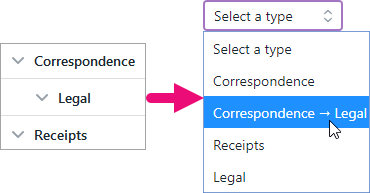You are viewing an old version of this page. View the current version.
Compare with Current View Page History
« Previous Version 42 Next »
https://help.myob.com/wiki/x/BYBhAw
How satisfied are you with our online help?*
Just these help pages, not phone support or the product itself
Why did you give this rating?
Anything else you want to tell us about the help?
Do not delete this page - MYOB Practice navigates to it from within the product
Practice administrators, you need to configure a few settings to give your practice access to some of the features of documents within MYOB Practice.
Configure your practice settings so that when staff upload or edit documents, they are given preconfigured options to choose from. These options categorise the documents, and staff in your practice can use some of these options to create document profiles. This helps staff in your practice quickly find and use the documents whenever they need them.
Quick start admin guide
Learn more about the settings you'll need to configure, make sure you've prepared the information you'll need, and then configure the settings.
Service settings
Define service categories that your practice will use to organise documents based on what sort of job it falls under. For example, allow your practice to tag a document as part of Auditing, Tax accounting or Financial planning work.
You can't delete a service, but you can rename it to mark it as obsolete. If you rename a service, the name is updated in the profile settings of any documents that you previously applied the service to.
We don't recommend changing the name of a service to something different to reuse it for something else. Instead, you can mark which service you don't want your practice to use any more by renaming it to have a code like zz at the start of the name.
You can't delete a service, but you can rename it to mark it as obsolete. If you rename a service, the name is updated in the profile settings of any documents that you previously applied the service to.
Period settings
Add the period categories that your practice will use to organise documents. For example, Q1, Q2, Q3, Q4. Or Jan, Feb, Mar through to Dec.
Don't use the Period settings to set up years like 2019 and 2020. There's a special Year field your practice can select from when adding a document. You can't configure the years in the settings; they'll update automatically each year.
Don't use the Period settings to set up years like 2019 and 2020. There's a special Year field your practice can select from when adding a document. You can't configure the years in the settings; they'll update automatically each year.
Document type settings
Add options that your practice can use to categorise documents by what type of document it is. For example, Correspondence or Legal.
When configuring the type settings, you see sub types in a hierarchical structure. But when a user selects a type for a document they're uploading, the document type and sub type are displayed together.

When staff in your practice add a document in the Documents page, they can choose from either the document type or document type and sub type together. For example, Correspondence or Correspondence > Legal.
Have a think about the categories that your practice's documents could be grouped into. What sort of services does your practice typically provide, and which of these would have documents associated with them? You need to add these services. For example:
- Tax & Financial
- Administration
- Corporate
- Special Projects
- Financial Planning
- GST
- Audit
- STP/Payroll.
You'll need to know the periods that your practice works within. For example, Jan, Feb, Mar through to Dec.
Work out the options you'll want to add for what type of document your practice might need to search for. For example, do you often need to store legal correspondence? Then you might want to add a document type of Correspondence, and then a sub type of Legal. You can add a document type or a sub type.
- On the left of MYOB Practice, click Settings and click Document profiles.


To add services:
- On the right of the Service settings section, click the edit icon (
 ).
). - Type each service relevant for your practice.

- Click Save.
- On the right of the Service settings section, click the edit icon (
To add the periods that your practice works within:
- On the right of the Period settings section, click the edit icon (
 ).
). - Type each period relevant for your practice.

- Click Save.
- On the right of the Period settings section, click the edit icon (
- To add document types:
- In the Document type settings section, click the edit icon (
 ).
). - Click Add a document type and enter the type.
- Click out of the field and click Save.
- Add another type or, to add a sub type of another type you've already added:
- Click the ellipsis icon (
 ) and click Add child.
) and click Add child. - Enter the sub type.
- Click out of the field and click Save.
If you want to Deactivate or Activate a type, click the ellipsis icon (
 ) to the right of the document type and click the relevant option.
) to the right of the document type and click the relevant option.To see deactivated document types, select Include inactive.
- Click the ellipsis icon (
- In the Document type settings section, click the edit icon (


 Yes
Yes
 No
No
 Thanks for your feedback.
Thanks for your feedback.